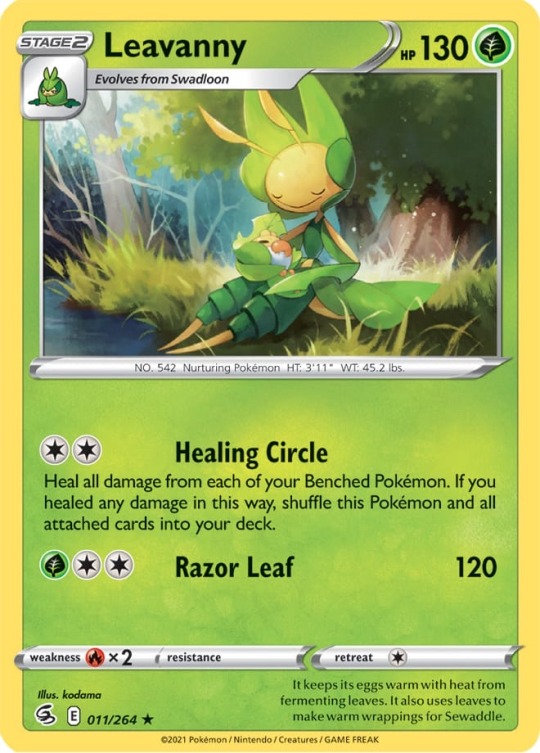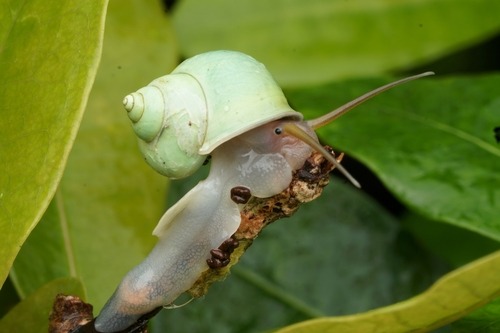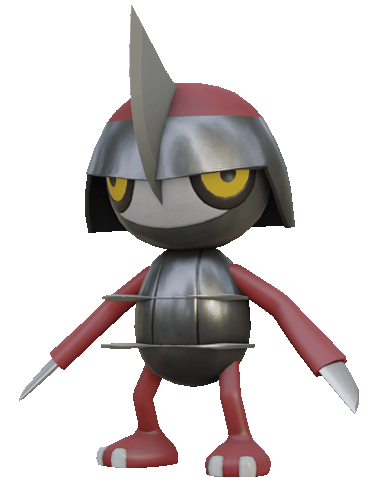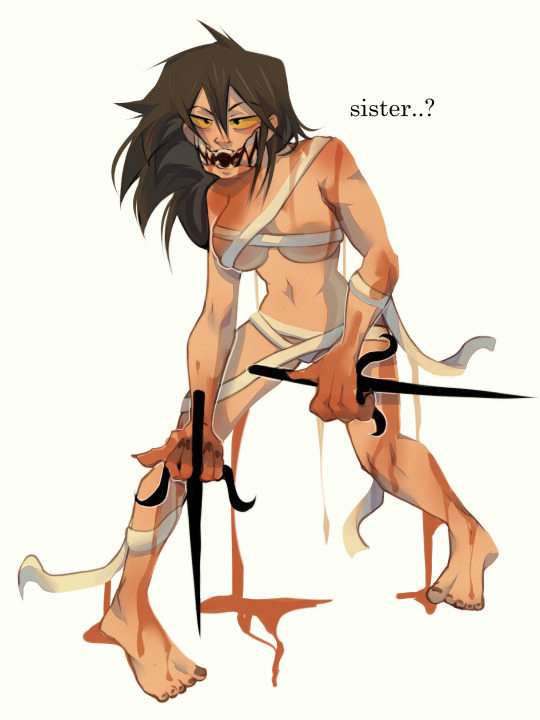She/her, ally, biology student, fan ofPokémon, Super Mario, Kirby, Legend of Zelda, Mortal Kombat. Please note, my blogs are meant to be a safe space, as I am anti hate speech/bullying and AI “art”. 🏳️🌈🏳️⚧️
Don't wanna be here? Send us removal request.
Text
Updated May 2025
Everything You Ever Wondered About Pawniard, Bisharp, and Kingambit Head Blades

The first thing you may be asking is how the head blade even originated. Pawniard’s evolutionary line is most closely related to crustacean Pokémon (a topic for another post), so their head blades are likely homologous with a structure that projects from the heads of others like Crawdaunt, known as a rostrum. While the crustacean rostrum is thought to help protect the eyes, it has been modified into an offensive weapon among Pawniard and its evolutions.
A Bisharp’s head blade is also seen as an important indicator of fitness, defined as the ability to both survive and reproduce. Pawniard are too young to breed, and lack the gold pigmentation of their evolutions’ head blades that may be a sign of sexual maturity.
As with all organisms, any traits that are meant to be adaptive are not without costs. A Bisharp having a dent in its head blade is seen as dishonorable, which means that it will be forced into retirement on its own without groups of Pawniard or opportunities to breed with other Bisharp. This commonly happens to older Bisharp that are heavily scarred and whose blades do not stay in good condition. Additionally, Bisharp keep the head blades of some defeated opponents as a sort of trophy, the Leader’s Crest that is.
Bisharp’s rarely achieved second evolution Kingambit has a significantly enlarged head blade, granting it the epithet of Big Blade Pokémon. The head blade alone weighs 40 kilograms or 88.2 pounds, constituting a third of Kingambit’s total weight. This appears to have been selected both for show and raw attack power. Kingambit have a reproductive advantage because Bisharp of the opposite gender show a preference to breed with them, and a female Kingambit produces approximately twice as many Pawniard eggs as a female Bisharp.
However, Kingambit are still far from “perfection”. They have lost Bisharp’s mobility at running and jumping, and can only get around by floating on their hair throne. Kingambit have also lost all other functional blades, most notably the retractable pair on the arms of both Pawniard and Bisharp. In addition, Kingambit also have particularly arrogant personality to match their oversized head blade, so much that they rush into battle alongside armies of their pre-evolutions without planning complex strategies.
In short, head blades in Pawniard’s evolutionary line represent a trade-off between signaling in beneficial and detrimental ways within the same species; as well as attack power versus skill.
Credit for the Pawniard, Bisharp, and Kingambit 3D models goes to @4lex-4nder.
42 notes
·
View notes
Text
Victreebel as a Vore Pred

According to this almost-vore scene in the early Pokémon Adventures Manga, Victreebel drags off humans and digests them as fertilizer in rituals to help Weepinbell evolve after gathering Leaf Stones. This idea will be used in one of my comic ideas done with @4lex-4nder, in a chapter titled “Putting the Victory in Victreebel”. The Kalos army befriends wild Victreebel on what is now Route 14, and promises to bring other human prey to them for the Weepinbell evolution ritual. During one of the military battles in Kalos, they lure soldiers from the Galar army towards the colony of Victreebel as a trap where many are devoured, and the casualties pile up as nearby Weepinbell evolve into even more Victreebel. Some soldiers are swallowed whole in the feeding frenzy, while others are dismembered first by Weepinbell and Victreebel using Razor Leaf, Leaf Blade, and Leaf Storm on them. Bellsprout are also present to grab any human morsels they can from the human buffet while the Kalos army scores a victory for the time being.
Victreebel is one of my only preferred soft vore preds, apart from Reptile from the Mortal Kombat series who can perform either soft or hard vore.
#pokemon#pokeblogging#pokemon blog#pokeblr#pkmn#pokemon blogging#pkmn blog#victreebel#weepinbell#bellsprout#vore comic#unwilling vore#vore pred#vore prey#fatal vore#soft vore#hard vore#soft v0re#hard v0re#digestion#fatal v0re#human prey#pokemon pred#pokemon vore#unwilling prey#voretendo#grass type pokemon#poison type pokemon#plant vore#voreblr
3 notes
·
View notes
Text
Happy Mother’s Day from Mandibuzz!

#pokemon#pokeblogging#pokemon blog#pokeblr#pkmn#pokemon blogging#pkmn blog#mandibuzz#vullaby#mother’s day#generation 5 pokemon#gen 5 pokemon#dark type pokemon#flying type pokemon
7 notes
·
View notes
Text
Happy Mother’s Day from Leavanny!

#pokemon#pokeblogging#pokemon blog#pokeblr#pkmn#pokemon blogging#pkmn blog#leavanny#sewaddle#grass type pokemon#bug type pokemon#generation 5 pokemon#gen 5 pokemon#mother’s day#swadloon
19 notes
·
View notes
Text
New and very important article from Bulbapedia


This article will be helpful for my Kalos war comic collab with @4lex-4nder in which Pokémon eat humans, and sometimes vice versa. Like the Mortal Kombat idea, this comic is designed partly for the vore crowd.
#pokemon#pokeblogging#pokemon blog#pokeblr#pkmn#pokemon blogging#pkmn blog#bulbapedia#pokemon vore#vore comic#pokemon predation#voretendo
14 notes
·
View notes
Text
Just another reminder that Pawniard is still adorable despite being covered with super sharp blades.

Pawniard is also ferocious (as I described in previous posts), so maybe take caution when trying to catch one.
This card is exquisitely detailed at showing the battle scars on Pawniard’s head.
10 notes
·
View notes
Text
Never-Before-Seen Leaked Concept Art of Tynamo and Eelektrik


More of my favorite obscure Pokémon that I actually haven’t posted much about due to having so little info in the games.
I couldn’t find Eelektross, so if anyone has that concept art, please share it.
#pokemon#pokeblogging#pokemon blog#pokeblr#pkmn#pokemon blogging#pkmn blog#electric type pokemon#tynamo#eelektrik#pokemon concept art#concept art#pokemon leaks#generation 5 pokemon#gen 5 pokemon
23 notes
·
View notes
Text


Green Tree Snails (Leptopoma taivanum), family Cyclophoridae, Okinawa, Japan
photographs: geeseinflight, Doo-yoon Kim
3K notes
·
View notes
Text
Miraidon meets Penny in the Pokémon Adventures manga

#pokemon#pokemon blog#pokeblogging#pokeblr#pkmn#pokemon blogging#pkmn blog#penny pokemon#miraidon#pokemon adventures#pokemon manga#cute pokemon
17 notes
·
View notes
Text
Updated April 2025
Pawniard, Bisharp, and Kingambit Sounds and Hearing

Pawniard, Bisharp, and Kingambit breathe air through lungs modified from the gill tissue of aquatic relatives like Krabby; which also contain phonic muscles and membranes for vocalization. As is the case with most first-stage Pokémon, Pawniard has a child’s voice. Pawniard is small in size, so its voice is higher than its evolutions. Bisharp’s voice deepens by an octave after increasing in size since evolving from Pawniard, but they are quiet most of the time unless using battle cries. In contrast to Bisharp, Kingambit is a lot more vocal, and has an even deeper, and much louder projecting voice that is used to call its pre-evolutions into battle as an army as well as warn enemies. This has been measured at over 100 decibels, and is amplified with additional metallic membranes in the respiratory system that Kingambit gains upon evolving from Bisharp.
Similar to many Bug type Pokémon, Pawniard, Bisharp, and Kingambit hear with tympana on the front of their bodies. Their exact hearing range is unknown, but likely surpasses the upper frequency limit for human ears, as Giacomo claims to play his records at a frequency that only his Pawniard can hear. The presence of tympana sets Pawniard and its evolutions apart from other crustacean Pokémon, which hear with sensory hairs on their bodies. Tympana have emerged independently among several arthropod Pokémon lineages, and indicate evolutionary lines that rely on hearing as a main sense.
14 notes
·
View notes
Text
Updated April 2025
Pawniard, Bisharp, and Kingambit Manual
General Information
Evolution
Pawniard evolves into Bisharp at level 52; which evolves into Kingambit after defeating 3 other Bisharp leading groups of Pawniard (each holding a Leader's Crest), and then leveling up.
Pawniard Info
National Pokédex #: 624
Category: Sharp Blade Pokémon
Type: Dark/Steel
Height: 1'08", 0.5 m
Weight: 22.5 lbs., 10.2 kg
Abilities: Defiant, Inner Focus, Pressure (Hidden Ability)
Gender Ratio: 50% male , 50% female
Egg Groups: Human-Like
Temperament: Active, Agile, Alert, Attentive, Charming, Cheerful, Confident, Curious, Dignified, Diligent, Eager, Fearless, Independent, Intelligent, Keen, Loyal, Persistent, Patient, Proud, Responsive
Diet: Carnivore
Bisharp Info
National Pokédex #: 625
Category: Sword Blade Pokémon
Type: Dark/Steel
Height: 5'03", 1.6 m
Weight: 154.3 lbs., 70 kg
Abilities: Defiant, Inner Focus, Pressure (Hidden Ability)
Gender Ratio: 50% male, 50% female
Egg Groups: Human-Like
Temperament: Active, Agile, Alert, Attentive, Calm, Confident, Dominant, Dignified, Fearless, Independent, Intelligent, Keen, Loyal, Patient, Powerful, Protective, Proud, Quiet, Responsive, Serious
Diet: Carnivore
Kingambit Info
National Pokedex #: 983
Category: Big Blade Pokémon
Type: Dark/Steel
Height: 6'07", 2 m
Weight: 264.6 lbs., 120 kg
Abilities: Defiant, Supreme Overlord, Pressure (Hidden Ability)
Gender Ratio: 50% male, 50% female
Egg Groups: Human-Like
Temperament: Alert, Assertive, Attentive, Calm, Confident, Dominant, Dignified, Fearless, Independent, Intelligent, Keen, Loyal, Patient, Powerful, Protective, Proud, Refined, Responsive, Serious, Sturdy, Vocal
Diet: Carnivore
Introduction
Pawniard, Bisharp, and Kingambit are Dark/Steel type Pokémon that are quite rare, and sought after by seasoned Trainers looking for a challenge. They are prized for their unique typing, Attack stat, intelligence, and property-guarding ability. Like ninja warriors, Pawniard and Bisharp are extremely agile and athletic in the way they move, and blend in well with dark surroundings. Bisharp are also capable of jumping to extreme heights, possibly 30 feet. While Kingambit are significantly heavier and have lost the agility of their pre-evolutions, they are sturdier and more able to take hits, as well as deal slightly heavier damage.
As Pawniard, they are attentive and persistent Pokémon that are constantly looking for something to do. Even though they are completely subordinate to their much stronger evolved forms, they are still independent thinkers who test boundaries and try to get their way. Thus they are difficult to train and need a Trainer who can be a confident and consistent “pack leader”, much like a Bisharp or Kingambit. However, Pawniard still train themselves constantly and love being in Pokémon battles, as their ultimate goal is to evolve in order to reach adulthood.
After evolving into Bisharp, they develop a calmer, quieter, and more stoic personality. They are also much more physically powerful. Bisharp is known as the “Meta Knight of Pokémon” due to its similarities to the iconic Kirby series character, in both its fighting prowess and behavior. They remain as independent thinkers that are not especially fond of having a boss, because they are naturally dominant over their pre-evolution, although their rare evolution Kingambit is dominant over them in turn. Bisharp are perfect as guard Pokémon, because they are naturally territorial, with great strength and weaponry that is enough to deter intruders. If they evolve once again into Kingambit, they trade their agility and fighting skill for increased bulk, making them more able to take damage, but only able to attack with brute force using the huge blade on their heads. Additionally, because Kingambit command entire armies of their pre-evolutions in the wild, they also give up Bisharp’s quietness and possess a deep, metallic amplified voice that makes them certainly not fit for apartment living.
In medieval Europe, Pawniard and Bisharp were kept by high-class knights, and were even knighted themselves. Like many others, these Pokemon were active both on the battlefield and as guards that protected castles. There was even a Bisharp general that led an entire legion of Pawniard during the war in Kalos that took place 300 years ago. However, Pawniard and Bisharp were actually the Pokémon of choice for more sinister knights who painted their armor black, in order to keep their coat of arms hidden so that the lord they served could not be determined. This has only added to these Pokémon’s reputation as mysterious and formidable creatures, even though many have served as noble protectors. Any Bisharp that managed to evolve into Kingambit were only allowed to be owned by royalty, just like Aegislash.
Because Pawniard, Bisharp, and Kingambit are listed as a potential danger to humans, they require an additional Pokémon license to legally own.
Pros and Cons of Bisharp
Pros
Has a very high Attack stat, and is good at getting critical hits
Has a high Defense stat
Excellent at guarding
Highly intelligent
Not clingy to people
Usually quiet
Resistant against 9 types (Dark, Steel, Ice, Grass, Normal, Flying, Dragon, Rock, Ghost), and immune to Psychic and Poison
Cons
Not a good fit for beginning Trainers
Takes a long time to evolve from Pawniard
May be highly destructive to property
Needs lots of exercise and enrichment
Headstrong personality, difficult to train
4x weakness against Fighting type, also weak against Ground and Fire
Learns no Special moves naturally, not a very diverse moveset
Pros and Cons of Kingambit
Pros
Has a very high Attack stat, and is good at getting critical hits
Has a very high Defense stat
Has a high HP stat
Its signature move Kowtow Cleave never misses
Excellent at guarding
Highly intelligent
Not clingy to people
Usually quiet
Resistant against 9 types (Dark, Steel, Ice, Grass, Normal, Flying, Dragon, Rock, Ghost), and immune to Psychic and Poison
Cons
Has a low Speed stat
Not a good fit for beginning Trainers
Is difficult to evolve from Bisharp
May be highly destructive to property
Needs lots of enrichment
Headstrong personality, difficult to train
4x weakness against Fighting type, also weak against Ground and Fire
Learns no Special moves naturally, not a very diverse moveset
Important Considerations for Owning Pawniard, Bisharp, and Kingambit
Providing enough exercise and mental stimulation: Pawniard and Bisharp are incredibly intelligent Pokémon that need plenty of exercise and behavioral enrichment. While Kingambit doesn’t need much exercise, it still needs as much mental stimulation as its pre-evolutions.
Their strong temperament: Pawniard, Bisharp, and Kingambit are not easily trained, and require an experienced Trainer who can take charge.
Late evolution: Pawniard does not evolve into Bisharp until level 52, and a Bisharp must defeat 3 wild Bisharp that lead groups of Pawniard and are holding a Leader's Crest to evolve into Kingambit.
Maintenance: Pawniard, Bisharp, and Kingambit need stones to regularly keep their blades sharp.
Destructive behavior: Pawniard, Bisharp, and Kingambit are likely to demolish home property and dig holes, especially if they are bored.
Care
Pawniard, Bisharp, and Kingambit are somewhat high-maintenance Pokémon because they fastidiously look after the condition of their blades, and must have whetstones to sharpen them on. For safety reasons, simply allow the Pokémon to do this itself. You must also provide pieces of wood or other items for it to test the sharpness.
Most of Pawniard, Bisharp, and Kingambit’s natural diet is meat. Their regular food should be supplemented with some fruits and vegetables, and raw meat such as Tauros or Unfezant meat at least a few times a week. Pawniard tend to eat a lot, due to them evolving at a late level and thus requiring lots of energy. Pawniard eats 1.5-2 pounds of food per day, Bisharp eats 5-6 pounds, and Kingambit eats 7-8 pounds.
Enrichment is an extremely critical part of owning Pawniard, Bisharp, and Kingambit as they need frequent stimulation. A favorite activity that Trainers do with these Pokémon is allow them to exercise their cutting abilities on newspapers or pieces of wood. This is similar to their natural behavior of cutting branches and weeds to test the sharpness of their blades. Another great activity to do with Bisharp or Kingambit is trimming trees and bushes as landscaping. Pawniard absolutely love taking time destroying cardboard boxes that are larger than they are, and those keep them occupied. During the process, they use their blades to cling to the box in the same fashion that they capture their more natural prey. It takes much less time for a Bisharp or Kingambit to demolish cardboard, but it still works.
Recall training is also an excellent form of enrichment for any Pokémon. Use a whistle or call the Pokémon’s name, and have treats or a toy ready so that the Pokémon is motivated to come to you. When using this for play, do it while hiding out of view of your Pokémon so that it has to find you, like hide-and-seek. Bisharp and Kingambit use a recall command with Pawniard in the wild, so this is much like a natural behavior.
Pokédex Entries
Pawniard
“Blades comprise this Pokémon's entire body. If battling dulls the blades, it sharpens them on stones by the river.”
“They fight at Bisharp’s command. They cling to their prey and inflict damage by sinking their blades into it.”
“Ignoring their injuries, groups attack by sinking the blades that cover their bodies into their prey.”
“After shredding its prey, it sharpens its blades on a stone by the river. Each Pawniard has its own favorite sharpening stone.”
“It follows Bisharp's orders to a tee when it attacks enemies. After slashing an opponent, Pawniard clangs both of its blades together.”
“It uses river stones to maintain the cutting edges of the blades covering its body. These sharpened blades allow it to bring down opponents.”
“A pack of these Pokémon forms to serve a Bisharp boss. Each Pawniard trains diligently, dreaming of one day taking the lead.”
“Pawniard will fearlessly challenge even powerful foes. In a pinch, it will cling to opponents and pierce them with the blades all over its body.”
“Any chips in its blades would prove fatal for it. After each battle, it diligently maintains its blades using its favorite sharpening stone.”
Bisharp
“It leads a group of Pawniard. It battles to become the boss, but will be driven from the group if it loses.”
“Bisharp pursues prey in the company of a large group of Pawniard. Then Bisharp finishes off the prey.”
“This pitiless Pokémon commands a group of Pawniard to hound prey into immobility. It then moves in to finish the prey off.”
“No matter how strong the Bisharp, it's said that if the blade on its head is chipped, it will retire from its position as the boss.”
“It leads a group of Pawniard. Bisharp doesn't even change its expression when it deals the finishing blow to an opponent.”
“It's accompanied by a large retinue of Pawniard. Bisharp keeps a keen eye on its minions, ensuring none of them even think of double-crossing it.”
“Violent conflicts erupt between Bisharp and Fraxure over places where sharpening stones can be found.”
“This Pokémon commands a group of several Pawniard. Groups that are defeated in territorial disputes are absorbed by the winning side.”
“Bisharp mercilessly cuts its opponents to pieces with the sharp blades covering its body. It will do anything to win.”
Kingambit
“Only a Bisharp that stands above all others in its vast army can evolve into Kingambit.”
“Though it commands a massive army in battle, it's not skilled at devising complex strategies. It just uses brute strength to keep pushing.”
33 notes
·
View notes













